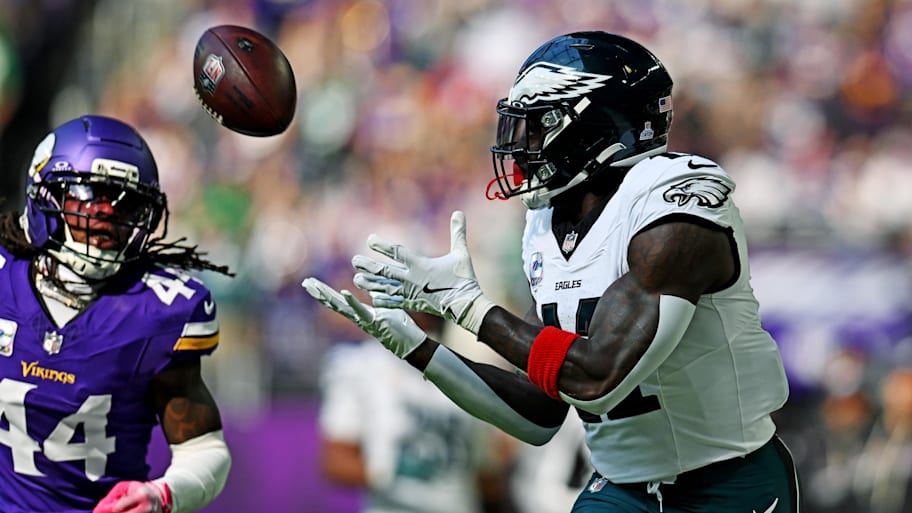
It was not the most enticing schedule here in Week 7, but we’re trudging along in the MMQB takeaways, covering all the drama and intrigue of mid-October …
Philadelphia Eagles
The Eagles aren’t hearing your panic. This is the reality of being in the market, and spot, that Philadelphia is in. The Eagles’ 4–0 start was picked apart like they were 0–4, and a two-game losing “streak” to follow sent local radio straight for the panic button. Was the blown lead to the Broncos and blowout loss to the Giants over a five-day stretch just a bump in the road, they asked … or a sign of something deeper with Nick Sirianni’s team?
As for the reality of the situation: Nobody’s more equipped for it than Sirianni himself.
In so many ways, he’s the right coach for a team loaded with talent and egos, playing in a pressure cooker of a football city. Mostly, because he doesn’t care that there are critics sniping at his ankles. As a result, his teams are generally less prone to fall into the trap, too.
“You’re not in control of what anyone thinks,” Sirianni told me as he was leaving U.S. Bank Stadium in Minneapolis on Sunday. “You are only in control of what you think. All [the noise] does is distract you from getting better, finding ways to win and finding ways to get better. What distracts you? If that’s something that distracts you then do whatever you need to block it out.
“You can’t let anything zap your joy or steal your focus. I think you see that in the best teams. They are mentally focused to get better every single week. They are mentally focused on the process every single week. Not necessarily the things they can’t control.”
In this case, the Eagles found a way to snap out of the rut they fell in the past two weeks.
And their 28–22 road win over the Vikings was as much a display of their resourcefulness and grit than it was their talent or upside. Minnesota, with Carson Wentz at the controls, was coming out of its bye after an up-and-down start to the season. Beating the world champs, and Wentz’s old team, was an opportunity for the Vikings to turn their season around. Entering the fourth quarter, they looked primed to do just that.
After interceptions on back-to-back possessions in the second quarter, one of which was a pick-six, Wentz had settled in. The Vikings’ array of receivers was showing up, with Wentz hitting eight different targets. Minnesota’s defense had put the brakes on the Eagles’ run game.
And that put plenty on the Eagles’ maligned pass game—piloted by Jalen Hurts, and fueled by A.J. Brown and DeVonta Smith.
“We’ve always been able to lean on our players, so we can get it done multiple ways,” Sirianni said. “That’s what good teams do. The Super Bowl last year, we didn’t run a lot but we were able to throw a lot. And we were able to win the game. It’s important to be balanced and that’s what we are.”
Sunday, though, they really weren’t, which is why Hurts, Brown and Smith were so important to beating Minnesota. The numbers were off the charts—Hurts had a perfect passer rating (158.3), and the two receivers combined for more than 300 yards and three touchdowns. The impact may have been even greater.
That was especially apparent in the fourth quarter. After the Vikings cut the Eagles’ edge to 21–19, back-to-back catches from Smith and Brown for 21 and 26 yards put it in the end zone, to make it 28–19. Minutes later, with the edge down to 28–22, Philly found itself in third-and-9 with 1:45 left, with the Vikings holding two timeouts.
Maybe Sirianni would’ve gone for the throat there regardless, rather than running the ball, forcing a timeout and lining up to punt. But having Brown and Smith on hand didn’t hurt. So he put the ball in Hurts’s hands.
“We are always going to be aggressive in those four-minute scenarios,” Sirianni said. “In that scenario, right, we were up one score [six points]. We are going to do whatever we need to do to win the game. I don’t think the run every single down and make them use their timeouts [strategy] is the right way to play those things. We work hard on situations. And if you look back on some of our past four-minute situations, we’ve shown to be aggressive.”
Hurts cashed Sirianni’s bet on the players, with a teardrop down the left sideline that Brown adjusted to and collected in bounds for 45 yards to finish off the Vikings.
It completed Hurts’s stat line with 326 yards and three touchdowns through the air, on 19-of-23 passing, with that perfect quarterback rating.
“I’m not sure I’ve ever been around that—where a quarterback has a perfect passer rating,” Sirianni said. “He made some great plays. His play to A.J. to seal the game, there was a guy free off the edge, he drifted away from it, laid it in there early. I told him I’ve seen him make a lot of good plays and that might have been the best play I’ve seen him make.”
Thus, another Philly “crisis”—and Sirianni’s seen plenty over his five years there—was managed.
For now, the Eagles are 5–2. They’ll try to avenge that Giants loss next week, then get their bye, then have the Packers and Lions in a Monday to Sunday turn, with both in prime time.
And along the way, Sirianni hopes, they won’t fall into the traps that have been set for them. Keeping the Eagles focused this year is, of course, tougher than it was before they were defending a championship. But at the very least, they’ve got a coach, and a program, built to deal with it.
Which people always seem to forget.
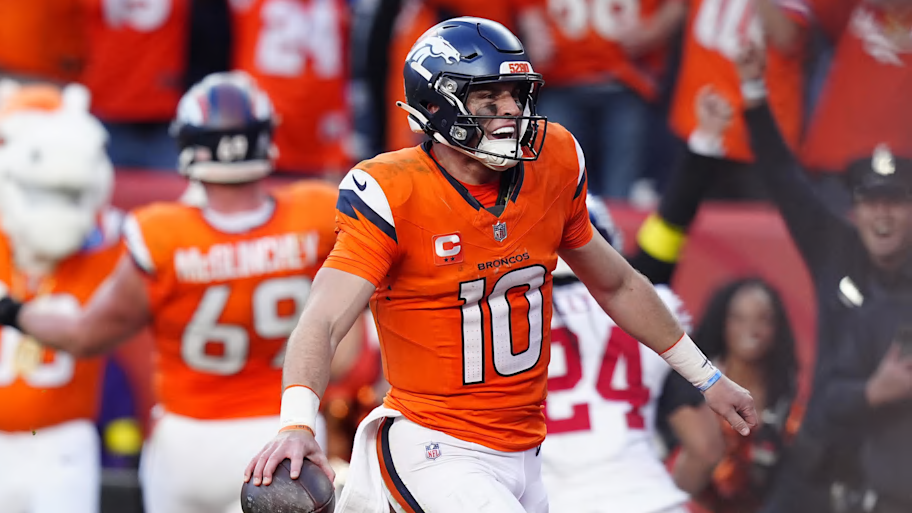
Denver Broncos
The Broncos’ win Sunday is more validation of what Sean Payton has built. I know, since he’s been a head coach, what everyone focuses on when looking at the now 61-year-old—mostly that he’s a quarterback-developing, offense-scheming, mad scientist of a play-calling boss. But dig into the foundation of what he’s always tried to build, and you might find something that looks different from what you’d think.
Payton models his team, in many ways, after Bill Parcells’s teams, principles he learned on the Tuna’s staff in Dallas from 2003 to ’05.
And on Sunday, and over the past three weeks, the grounding that Payton has given the Broncos has led them to a lot of good things. First it was the comeback win in Philadelphia. Last week, it was a knockout of the Jets in a bare-knuckle brawl in London. This week, it was something more historic—the Broncos trailed the Giants 19–0 entering the fourth quarter and somehow, someway, wound up winning, 33–32.
Again, that was after going from Denver to Philly to London, then coming back across seven time zones for a Colorado home game without a bye.
“We are fighters,” receiver Marvin Mims Jr. told me after beating the Giants. “East Coast game and going through London and coming back is not easy. That’s the task. We have to take it and run with it. For me, mentally, it’s a week-by-week thing. We were able to be home this week and get into a groove. Even though we started slow—we want to start off better than that—we’re fighters and we finished the game.”
To Mims, and a lot of the other Broncos, being ready for what they’ve faced is why Payton’s been so tough on the players the past three summers. They have two-and-a-half-hour practices when so many teams rarely go over 90 minutes. They max out the number or allowable full-contact practices. It’s done, in Payton’s phrasing, to build a callous.
“The way we’ve practiced hasn’t gone without notice,” Mims continued. “We feel it—and the other team feels it. We take pride in that.”
And that’s what made the way Sunday’s comeback came together even more impressive.
It was after three full quarters of action, a bunch of on-field failure and the aforementioned travel. Also, it was accomplished with a gamble that the Giants would lose their wind before the Broncos did. Late in the third quarter, needing a spark, Denver went tempo, necessary because of the deficit and beneficial, Mims said, because, “We’re a really good offense when we’re playing fast. I always relate it to a college offense, and we’ve got a lot of young guys.”
It produced an eight-play, 78-yard touchdown drive; a 13-play, 74-yard touchdown drive; a four-play, 19-yard touchdown drive off a turnover; and a six-play, 68-yard touchdown drive capped by a designed run from Bo Nix for an 18-yard score to give Denver a 30–26 lead. And then, after all that, Nix drove Denver 56 yards in four plays to set up the game-winning field goal. They covered those yards when Mims found a dead spot in the Giants’ zone for 29 yards, then Nix gave Courtland Sutton a chance in man coverage, leading to a 22-yard connection on an out-breaking route to put the Broncos safely in Wil Lutz’s range.
At the beginning of that sequence, Sutton came in the huddle, per Mims, and told his teammates he believed in them. They justified that belief, and then some.
And justified some long summer days along the way as well.
Indianapolis Colts
It’s getting tougher and tougher to doubt the Colts. It’s not just their record. It’s how they’ve gotten to 6–1, too. Sunday’s 38–24 road rout of the Chargers was Indy’s fourth double-digit win of the season. The Colts’ point differential of plus-92 is a full 30 points better than everyone else (the left-for-dead Chiefs are second, by the way). And the idea that this team quietly held over the course of the offseason that it was a quarterback and defensive scheme change away from being a very real contender is proving itself out.
The Colts’ only loss, in fact, came in their previous trip to SoFi Stadium, when they played the Rams in Week 4, and it might not have happened were it not for a slew of self-inflicted wounds.
So, yes, Shane Steichen’s crew is damn good. And, yes, they saw it coming, too.
“Over the years, we’ve been so close, literally a game away,” captain DeForest Buckner told me, from the bus headed for LAX. “A lot of our core guys have been here for years. When I first got here, they were all younger guys, but they were still key players. Finally, this year, we got a couple pieces that we needed in the offseason. We're getting some high-level play, consistent play from the quarterback.
“We always knew we were close and getting this group together this offseason really solidified our thoughts.”
A quick check of Sunday’s stat lines proves Buckner’s point. Jonathan Taylor, in his sixth year with the Colts, had 132 scrimmage yards and three touchdowns. Homegrown wideouts Michael Pittman Jr. and Alec Pierce combined for 12 catches, 156 yards and a touchdown. Every starter on the offensive line was developed in Indy. Grover Stewart, Nick Cross and Zaire Franklin made plays on defense, and Buckner, though not drafted in Indy, is now in his fifth year with the Colts, and had the sack that essentially closed out the Chargers.
And speaking of that sack, that was the final of a string of responses the Colts had ready for their hosts when they worked to mount a late comeback Sunday. When L.A. cut the lead to 23–10 at the start of the second half, Ameer Abdullah took the ensuing kickoff back 81 yards, and Taylor scored two plays later. When the Chargers got it back to 31–17, Indy swiftly went 73 yards in five plays to make it 38–17.
Then, there was Buckner’s sack, which came with less than five minutes left, to put the Chargers in an untenable third-and-22. L.A. ran just two more offensive plays thereafter.
“That goes to the preparation we did in the offseason,” Buckner said. “We always talked about in the fourth quarter being able to wear out teams. That’s why we changed up training camp, made it harder, had to push through some tough days. We always said, in the fourth quarter, we want to be the team that’s able to outplay the opponent, and we have.”
And as Buckner said, with Daniel Jones giving them the play they’ve needed at quarterback, and Lou Anarumo running the defense, the league’s view of the Colts is changing.
The last time they were 6–1, by the way, was in 2009, in Peyton Manning’s final full season as the Colts’ quarterback. That year ended in the Super Bowl appearance for Indy.
At this point, the Colts have at least given their fans a chance to fantasize about that kind of run again. Soon enough, we’ll all know how realistic, or unrealistic, it might be. But, for now, we at least know where the players stand on that—and rightfully so.
Chicago Bears
There’s been so much focus on Caleb Williams to this point that few have actually looked at the style of offense Ben Johnson is deploying with the Bears. Believe it or not, it’s one that’s only gone over 250 net passing yards once. And it’s slowly and surely built a head of steam on the ground, to the point where Sunday, Chicago rolled to 222 yards rushing on 40 carries, to key the team’s fourth consecutive win, this one 26–14 over the Saints.
Wasn’t what you expected?
Well, over the summer, we wrote in a few different places that Ben Johnson was feeding his offensive players through a firehose to try to figure out what they do best, to then tailor a scheme to those things. So it would made sense, given the presence of a young quarterback and veteran line, that the team would go this way. But the truth is that Johnson told the players, in his own way, that they’d wind up, in some form or fashion, looking this way all along.
“He told us the brand of football we wanted to play,” tailback D’Andre Swift told me. “That’s a physical unit that does everything—the run, pass, play-action. Whatever that particular game day requires us to do to come out with the win, we’ll execute that. Situations, weather, can dictate play calls and things like that, but we want to be very balanced in everything to do as far as our identity. And we’ve picked up the run game the last couple weeks.”
So it was that the Bears’ first two touchdown drives, after stalling out some in the first quarter, encompassed just three pass plays total. And at the end of the game, after pounding away on the Saints’ defense for three-plus quarters, Chicago leaned even harder into that physical edge that Johnson once helped Dan Campbell cull in Detroit.
Getting the ball back at their own 32 with 4:20 left, that 26–14 lead, and New Orleans holding all its timeouts, the Bears ran rookie Kyle Monangai off right tackle for 24 yards. Two plays later, Swift picked up another 11 yards off the right. Then, two Monangai runs got the Bears into fourth-and-3, which Williams converted with a quick-hitter to Colston Loveland to essentially end the game.
“That’s mentality right there, that’s perseverance, that’s resiliency,” Swift said. “Like you said, everyone in the stadium knows what the teams are doing in four-minute [offense]. So to be able to finish the game with the ball in the offense’s hand, that’s what we’re trying to do. That was good to see, good to be a part of.”
It makes things easier on Williams, and a fast-improving defense, too.
So maybe it doesn’t look exactly like some folks expected it to, in Johnson’s first year. But it sure is working, and in largely the same way it did a couple of years ago, in another NFC North locale.
Which also, in a roundabout way, made the mission ahead clear—hand that group back to Burrow, maybe at some point in December, with a fighting chance to chase a championship.
“I’m not necessarily looking that far ahead—but, sure,” he said. “Is that my job? Is that my task? Well, then I’m gonna do that goddamn task as best as I possibly can. I sure hope that’s the case, yes.”
And in the interim? He’s gonna enjoy every minute of getting to do it.
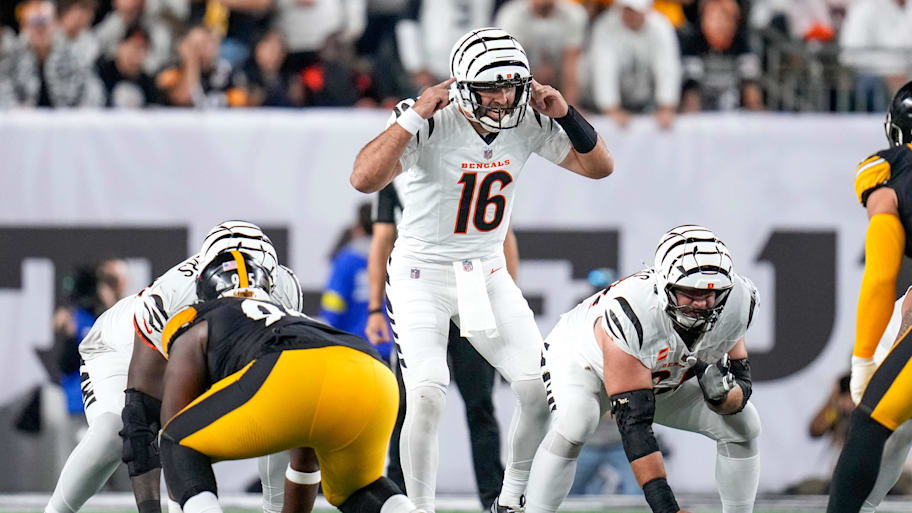
Joe Flacco
I love Joe Flacco’s perspective. I have for a while, and I have a renewed appreciation for it after the Bengals’ breakneck 33–31 win over the Steelers on Thursday night.
Yes, part of that has to do with the 342 yards and three touchdowns he threw for against Pittsburgh, and that it came just nine days after he was dealt from the Browns to their cross-state division rivals. But it’s also about a guy who told me about 12 hours after it was over that he took a few extra minutes in the locker room postgame, and more time than a player normally might with Ryan Fitzpartrick, Richard Sherman and Andrew Whitworth—players of his generation—on the Amazon Prime set afterward for obvious reasons.
“You have to,” the 40-year-old said, over the phone Friday morning. “Because, listen, it is fun. It’s enjoyable when you’re doing things like last night. And there’s a lot of pressure, man, with this game. And even though I’ve been playing it for so long, I still get those feelings before a game. They’re not that much fun—I don’t want to have those feelings. But fighting through that, you don’t get to experience the level of fun that I had last night, unless you’re able to get over those feelings. And, yeah, that takes it to a whole other level.”
It was quite a night for the rest of us, so you can only imagine how Flacco felt. So with that in mind, here’s a little more from my conversation with the 18-year vet.
• Flacco’s actually thankful to the Browns, who told him before trading him that they’d do the trade if it were something he’d be interested in. “Now I don’t know if they would’ve done it anyway, if I wasn’t interested. If I said, No, I really don’t want to do that, guys, I don’t know if they would’ve said, O.K., yeah, that’s cool, we won’t do it then,” Flacco said. “But it did seem like [GM] Andrew [Berry] was like, Listen, man, we appreciate what you’ve done. Would this be something you’d be open to? So we had a conversation about it, for sure.”
• So would Flacco have given the green light if it were another team (rather than Cincy) calling? “That’s hard to answer,” he said.
• The challenging part of the transition, he says, was learning the new language. The concepts, “thankfully,” were all familiar. “It was getting to the point where I can communicate it clearly enough to make sure everyone knew what they were doing,” he said. “Because once I broke the huddle, I really did have a clear picture in my mind of what we were doing.”
• We mentioned in our Thursday column that Flacco and center Ted Karras were having lunch film sessions together—“Ted’s great”—but there was someone else in there for it, too. “When Ted and I met, Joe [Burrow] went up there and sat with us, and just chimed in. Here’s how I would do that. Here’s what I would tell the guys,” Flacco said. “And it was one of those things where I could say, O.K., I’m not gonna worry about that, or, O.K., that’s helpful. You can tell [Burrow] is invested.”
The roll the Bengals got on Thursday night started, in Flacco’s mind anyway, just before the half at Green Bay, when they went 44 yards in 1:06 to set up a 67-yard field goal try by Evan McPherson. The attempt failed, but the momentum carried over, and Flacco was taken enough by the end of the game that he was sitting with one of his brothers, laughing about how good he has it throwing to Ja’Marr Chase and Tee Higgins. “These guys are just different,” Flacco told his brother.
Which also, in a roundabout way, made the mission ahead clear—hand that group back to Burrow, maybe at some point in December, with a fighting chance to chase a championship.
“I’m not necessarily looking that far ahead—but, sure,” he said. “Is that my job? Is that my task? Well, then I’m gonna do that goddamn task as best as I possibly can. I sure hope that’s the case, yes.”
And in the interim? He’s gonna enjoy every minute of getting to do it.
Tennessee Titans
The next thing Amy Adams Strunk has to give her football people is time. The Titans’ owner’s issues have been documented over the past week (I chimed in, too). She’s had to face a lot of difficult, yet valid criticism. So, as the organization pulls itself from the ashes of the past week (and really the past three years), and charts yet another course to turn things around, it’s on Strunk to trust the people she’s entrusting.
Those people, as of this writing, are president of football operations Chad Brinker and general manager Mike Borgonzi.
You can go, chapter and verse, through all the things that went wrong, as we did last week. The overreaction to the A.J. Brown trade led to the firing of GM Jon Robinson. The decision, a year after giving Mike Vrabel more power, was to reinvent the wheel because of the climate in the office and fire Vrabel. The hirings and firings of successors Ran Carthon and Brian Callahan were independent of one another. All of it is a mismanagement masterclass.
Now, she’s left with another search for a decision-maker looming. And I’d say this with all due respect: Strunk’s best move would be to stay out of it. She primarily did in the GM search, as Brinker tabbed Borgonzi, and I actually think the early returns on that hire are pretty decent, with a strong set of front office hires after the GM decision.
That’s currently the plan, as I understand it. Brinker and Borgonzi will lead the coach search, without a search firm. They’ll lean on the group they’ve assembled, which includes former GMs Dave Ziegler and Reggie McKenzie, as well as a rising young exec in Dan Saganey. The research to fuel it has already started. The study includes things, for example, like the track record of second-time head coaches with plus-.500 records, and coaches with five-plus years of play-calling experience before their hires.
I also believe that group will be open-minded, rather than just drilling down on simple ideas like simply focusing on a young offensive coach (which is what Strunk wanted, and got, in 2024) or an ex-player (which is where the franchise has had its most success since relocating from Houston, with Jeff Fisher and Vrabel). And that in the end, they’ll wind up with a Lions (Dan Campbell–Brad Holmes–Mike Disner) or Packers (Matt LaFleur–Brian Gutekunst–Russ Ball) type of setup between the coach, Borgonzi and Brinker.
Here’s the other thing I think Strunk needs to remember: Whoever the coach is, this is going to take time. The past three years have left a mark. It won’t be a one-season fix for Mike McCarthy (who has ties to Brinker), Matt Nagy (ties to Borgonzi), Arthur Smith (ties to the franchise) or whomever else the team winds up catching in the wide net it’ll cast. When you’ve had different people drafting and signing players for various systems and philosophies, there’s a lot of untangling to be done.
That’s going to require patience. Strunk hasn’t had much of late. But she’ll need to get some now, if the Titans are going to have a chance to fix it.
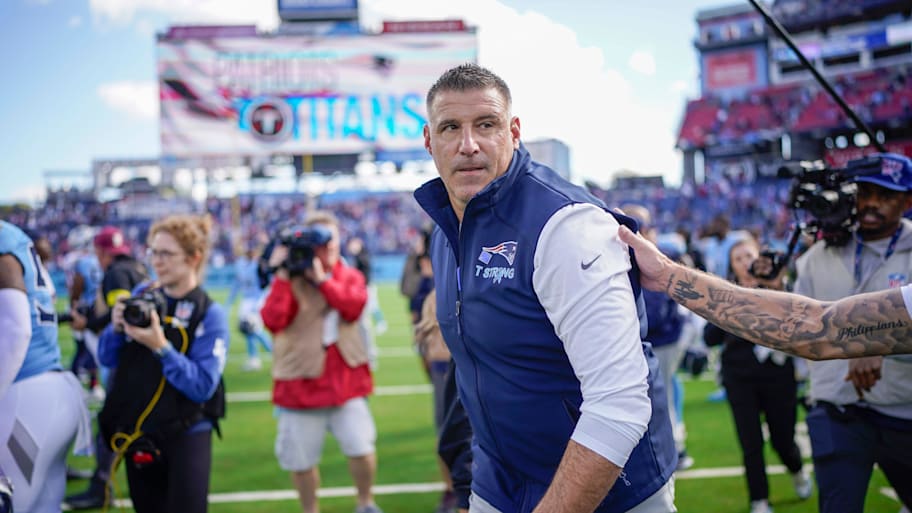
New England Patriots
For what it’s worth, the Patriots very clearly wanted that one for Mike Vrabel. And it was apparent in the postgame locker room, when the coach was again avoiding the storyline that a lot of folks in Massachusetts and Tennessee were obsessing over all week—his own return to the stadium he called home for six seasons.
According to Stefon Diggs, Vrabel told the players, in reference to that narrative, that “every week is personal.” But after a 31–13 rout of the Titans, the players weren’t going to let their coach off that easy.
As Vrabel was wrapping up his postgame speech and walking away, Drake Maye yelled, “Hold on, one sec, one sec …” Then, Maye, Diggs and Hunter Henry closed in on him from opposite sides, the rest of the team converged on him and Maye addressed his coach: “Coach Vrabel, we love playing for you, we’re glad you’re our coach. We love you, Coach.”
Maye stuffed a game ball in Vrabel’s midsection, and it was well-deserved, for sure.
The 50-year-old former Patriots linebacker has absolutely changed the face of a franchise that had seriously hit the skids the past few years. The root of a lot of the problems of the end of the Bill Belichick era have only been confirmed in the legendary coach’s first year at North Carolina. Jerod Mayo’s only season in charge showed how deep-seated the issues were, going well beyond just Belichick. And all that only highlights the difference Vrabel has made.
So on one hand, Sunday was different, regardless of what Vrabel told anyone. “I don’t care what he said,” Diggs told reporters. “We wanted to win this for him.” On the other hand, this was a continuation of what’s been going on—where the Patriots have balanced out their roster, much like the Commanders did last year in Dan Quinn’s first year, with middle-class, system-fit veteran additions, and a fast-rising young quarterback putting it over the top.
And that, as Vrabel will tell you, is about the players, because of the player-centric culture he’s put in place. One place where it’s certainly showed up is in how Vrabel talks about his guys. The Patriots went through turnover and penalty issues early in the year, and Vrabel never positioned it as the biggest problem in the world. Why? Well, in Los Angeles, Sean McVay has a saying—something along the lines of, “The players can never meet the enemy on the sideline.” Vrabel’s right-hand man, John Streicher was with McVay last year.
It’s the way he operates anyway, but it’s pretty clear that kind of approach is in place in New England—where Vrabel won’t call out his players publicly, even if he’s aggressively addressing their issues internally. As a result, the players know Vrabel has their back.
On Sunday, in dominating the Titans, the Patriots showed they have his, too.
Cleveland Browns
Cleveland Browns
We’ll get to the Browns’ opponent from Sunday in a second but, for now, let’s give Cleveland some credit. In April, GM Andrew Berry and that front office weren’t exactly applauded for their decision to trade the No. 2 pick, and the rights to draft a true unicorn in Travis Hunter. But their logic was always sound—their core was aging out, the Deshaun Watson draft pick drain had taken a toll and they needed to get a lot younger.
Dealing away the second selection would allow them to do that, with a deeper war chest of picks creating more margin for error and a better chance to spread youth across the roster.
So far, I’d say, so good.
In Sunday’s 31–6 bludgeoning of the Dolphins, the Browns’ leading passer, rusher, receiver and tackler were all rookies. Dillon Gabriel threw for 116 yards on 13-of-18 passing on a cold, rainy afternoon. Quinshon Judkins rushed for 84 yards and three touchdowns on 25 carries, with Dylan Sampson carrying it three times for eight yards. Harold Fannin Jr. had four catches for 36 yards (again, in very messy weather). And middle linebacker Carson Schwesinger led a stout defense with seven tackles.
“It’s just the confidence they’ve had in us from the beginning, whether it’s the coaches, the front office or other players,” Schwesinger told me postgame. “I think as a rookie class, we all have great work ethic and that’s helped us earn respect from all those groups of people.”
It’s also allowed for Schwesinger and Gabriel to quickly ascend into leadership roles—Gabriel, obviously, is running the offense, while Schwesinger wears the green dot on defense—that have to be earned both on and off the field.
“The two of us, we play fast,” Schwesinger said, “and that’s what they want us to do.”
So how far will this go? Well, add the aforementioned names to No. 5 pick Mason Graham, who’s shown potential to be a dominant interior defensive lineman, and you have a really good group to work with, then two first-round picks next year, and you start to see where Cleveland could be flipped pretty quickly.
And that, to me, is more than one guy (unless he was a quarterback) could’ve accomplished for the Browns, regardless of how good Hunter becomes.
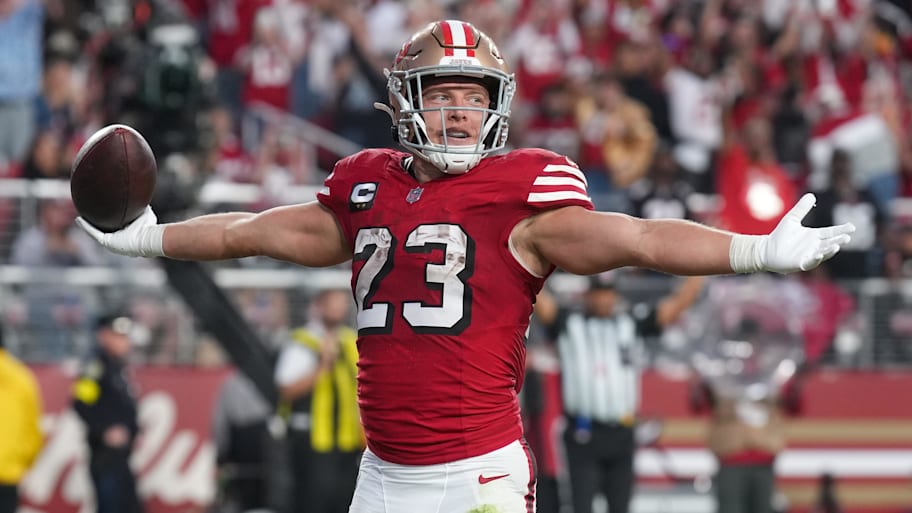
San Francisco 49ers
The 49ers’ continued success is ridiculous. Missing from the lineup on Sunday, still, were Brock Purdy, Nick Bosa and Fred Warner. George Kittle was back, for the first time since Week 1. Two receivers (Kendrick Bourne, Skyy Moore) and a running back (Brian Robinson Jr.) who spent training camp with other teams played major roles Sunday night.
And yet … 49ers 20, Falcons 10.
How does this make any sense?
“I wish I knew the definite answer,” longtime Niners fullback Kyle Juszczyk told me. “It’s hard. You look at it on paper, it doesn’t add up. You lose that many guys, you should not be 5–2 or have the division record we do [3–0]. I give credit to the culture that the guys we’ve lost have built. The younger guys know there’s a certain standard to the way we do things and how we play. So when it’s their opportunity, they’re not surprised. They’ve experienced it.
“They’ve felt it on the practice field.”
Juszczyk then stopped himself, and added, “That’s the only thing I can think of and why they’ve been able to step in there so seamless.”
In the case of Sunday night, the Niners didn’t have to dip too deep into the well of replacements, because their bell cow, Christian McCaffrey, did just about everything, with 201 scrimmage yards and two touchdowns on 31 touches.
But over the course of the season, they’ve had to rely on guys such as Mac Jones, Bourne and Bryce Huff to make up the difference in what was lost. And somehow, inexplicably, more often than not, that’s just what those guys have done. In fact, it actually happened Sunday, with Tatum Bethune, who filled in for Warner and posted a team-high 10 tackles. And it didn’t stop there.
“It’s easy to say Tatum Bethune, he’s got the biggest shoes to fill with Fred being out,” Juszczyk said. “Chase Lucas has made great plays—he was the preseason MVP. Every opportunity he’s been called on, he’s done a great job. A number of them today. We had another injury, losing our starting center today [Jake Brendel], Matt Hennessy came in there and did a great job. We ran the ball 39 times today, so we must be doing something right today.”
All the Niners must be, really.
And that’s why the goals they had when Bosa and Warner were still around haven’t shifted, even if the faces have.
“The goals are the same,” Juszczyk said. “We’re going to have to get there a different way. We knew in the offseason in order for us to win, we would need a lot of guys to step up and play well. We’ve been fortunate that a lot of guys have done that. That’s a big reason we are here.”
Among others.
Quick-hitters
All right, let’s jump right in on the quick-hitting takeaways. Right now …
• The Chiefs’ belief is that Rashee Rice is going to change their offense’s dynamic. They see him as a top-10 receiver with RAC ability that’s going to cause problems for defenses in the space that burners Marquise “Hollywood” Brown and Xavier Worthy clear out. And in his season debut Sunday, his physicality proved a difference-maker in the red zone, with his two touchdown catches coming with the Chiefs already inside the 5-yard line.
• I think Dolphins owner Stephen Ross and president Tom Garfinkel will have an interesting conversation Monday morning over the future of their football operations. Coach Mike McDaniel’s program seems to be teetering. Over the past couple of years, McDaniel lost some players in giving star treatment to guys like Jalen Ramsey. This offseason, they worked to clean the locker room out, and emphasize character in the player acquisition. If that doesn’t work, and right now it’s fair to say that it hasn’t … then what?
• Take a bow, Chris Shula. The Rams’ defensive coordinator’s unit kept the Jaguars off the scoreboard through their first six trips into Los Angeles territory (a Travis Hunter touchdown finally broke the drought). Shula’s done a really nice job developing young talent and evolving the scheme that Raheem Morris left him almost two years ago.
• The Panthers are over .500 for the first time in four years, which is amazing in ways that aren’t all that flattering to the franchise. Credit to Dave Canales for keeping the group together through some really rough weeks. And that run game, with Rico Dowdle getting the ball a lot, is legit.
• Another week, another MVP-level performance from Dak Prescott. Unfortunately for Prescott, I don’t think the Cowboys are going to be good enough on balance for the quarterback to win the award. But he deserves a look. He’s at 1,881 yards and 16 touchdowns with just three picks, and a 107.6 rating through seven games. That projects to 4,568 yards, 39 touchdowns and seven picks over a full season—and, remember, he just got CeeDee Lamb back.
• I still think J.J. McCarthy’s the best option for the Vikings. Whenever he’s ready to go.
• Speaking of the Vikings, their game with the Chargers on Thursday is a big one for both teams. And given the injury issues on each side, you wonder how many guys will sit, to get the full 10 days of rest after the game, looking ahead to Week 9 (when the Vikings travel to Detroit and the Chargers visit Tennessee).
• That’s a good win for the Packers, in Arizona, especially with Micah Parsons coming around with a career-high three sacks. Also, from there, it’s at least interesting how competent Jacoby Brissett has looked running the Cardinals offense.
• There’s still no consensus top quarterback in the 2026 draft, which isn’t great for fans of teams looking for one. LSU’s Garrett Nussmeier, South Carolina’s LaNorris Sellers, Clemson’s Cade Klubnik and Penn State’s Drew Allar (who’s now hurt) are among those who’ve failed to take the step forward many expected. Yet, at least.
• Best game of the weekend (Buccaneers-Lions) is at 7 p.m. ET Monday night. And … who’s gonna make it through Texans-Seahawks?!? (I love the matchup, but a 10 p.m. ET kickoff may lead to an unintentional nap for your neighborhood football reporter.)
More NFL From Sports Illustrated
This article was originally published on www.si.com as Week 7 NFL Takeaways: Why Nick Sirianni Is the Right Coach for the Eagles.







